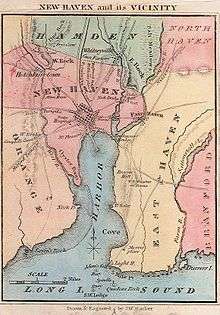Robert Seeley
| Robert Seeley | |
|---|---|
| Born |
1602 Bluntisham, Huntingdonshire, England |
| Died |
1668 New York, Province of New York |
| Nationality | English |
| Occupation | landowner, second in command in Pequot War, |
| Known for | Founder of Watertown, Massachusetts, Wethersfield, Connecticut, and New Haven, Connecticut |
| Spouse(s) | Mary Mason |
| Children | Nathaniel |
Robert Seeley, also Seely, Seelye, or Ciely, (1602-1668) was an early Puritan settler in the Massachusetts Bay Colony who helped establish Watertown, Wethersfield, and New Haven. He also served as second-in-command to John Mason in the Pequot War.
Early life
Robert Seeley was born in Bluntisham-cum-Earith, Huntingdonshire, England in 1602. His father William was a joiner (cabinet maker) . In 1623 Robert moved to London, where he became an apprentice cordwainer (shoemaker). He married Mary Mason, widow of Walter Mason, in 1626 and began attending the church of the Puritan minister John Davenport that same year. On 16 September 1627 Robert and Mary's only child, Nathaniel,[1] was baptized at St Stephen's Parish, Coleman Street, London.
The Great Migration
In 1630 Robert, Mary and Nathaniel sailed with John Winthrop as a part of the original Puritan expedition to Massachusetts. Soon after arriving in the New World, Seeley became one of the original forty settlers of Watertown, one of Massachusetts' earliest Puritan communities. He employed his training in surveying by laying out many of the plots for the settlers. He was granted freeman status in 1631.
Wethersfield and the Pequot War
In 1633 or 1634, Seeley joined a ten-man expedition led by John Oldham to the Connecticut River. The group soon established Wethersfield, the first English settlement on the Connecticut River. Oldham's death in 1636, presumed by the colonists to be at the hands of the Pequot, helped touch off the Pequot War in 1637. Seeley served as second-in-command to Captain John Mason in the war. He was severely wounded by an arrow to the head in an attack on a Pequot fort along the Mystic River. Captain Mason, who called Seeley a "valiant soldier", wrote of the incident, "Lieutenant Seeley was shot in the eyebrow with a flat headed Arrow, the Point turning downwards. I pulled out the arrow myself." Seeley carried a permanent scar from the wound.
New Haven

When his old friend John Davenport arrived in Massachusetts, Seeley joined his group and helped establish the New Haven Colony in 1638. Seeley served as New Haven's first town marshal and lieutenant of the militia. He was generally known in the community as Lieutenant Seeley. He also participated in Theophilus Eaton's exploratory expedition in Long Island Sound.
Later life
In 1659 Seeley briefly returned to England, living there until 1662 when he returned to the New World and settled in New Amsterdam (present-day Huntington, New York) on Long Island. He died in New York City in 1668. In 1695 his heirs received 40 acres (160,000 m2) of land in Watertown, resolving a suit which Seeley had filed 60 years earlier after settling in Wethersfield. In the suit he had claimed that he had not been given the area promised to the original settlers of Watertown. Seeley's son Nathaniel was killed in the build-up to the Great Swamp Fight during King Philip's War.
Honors
- Robert Seeley's name is featured on three historic plaques listing town founders, in Watertown, Wethersfield, and New Haven.
- He is listed on a historic plaque at the base of a statue honoring John Mason as one who helped achieve victory for the colonists over the Pequot.
See also
References
- ↑ Seeley Genealogical Society
- A Brief History of the Pequot War by Major John Mason, with an Introduction by the Rev. Thomas Prince (Kneeland and Green, Boston, 1736)
- "The English Life of Robert Seely" by Ralph M. Seely in The New England Historical and Genealogical Register (July 1962)
- Huntingdon Town Records, Vol. 1 by Charles R. Street (1887)
- "The Pequot War," http://www.colonialwarsct.org/1637.htm, from The Society of Wars in the State of Connecticut website
- The Public Records of Connecticut, Vol. 1 by J. Hammond Trumball (1850)
- Records of the Colony and Plantation of New Haven from 1638-1649 by Charles J. Hoady
- Seely History by Montell Seely and Kathryn Seely (Community Press, 1988)
- Watertown Records by the Watertown Historical Society (1894)
External links
- The Pequot War from The Society of Colonial Wars in the State of Connecticut
- 1736 version of John Mason's account of the Pequot War
- The Winthrop Society is a hereditary organization made up of the descendants those who arrived on the Winthrop Fleet or other Great Migration ships before 1634.
- Passenger list of the Winthrop Fleet (spelling is Seely on this list)